“I should like to see Rome,” she said; “it must be a lovely city, or so many foreigners would not be constantly arriving there.”
– Beauty of Form and Beauty of Mind, Hans Christian Anderson
Buenos Aires – Here’s the legend in a nutshell. Romulus and Remus (not Regulus and Remus from Harry Potter) were twin brothers, children of the War God, Mars. Their great-uncle, on mom’s side of the family, tried to drown them in a river so that they wouldn’t grow up and take back the kingdom he’d stolen from his brother. But, of course, they survived, were raised by a wolf, grew up, some shepherd told them they looked like members of their mom’s family, so they killed their uncle and took back the kingdom, restoring it to their grandfather. They decided to move somewhere else and build a town, because grandpa turned out to be a royal pain. Romulus was in charge of building the fortification wall, Remus made fun of him because he thought they were too low to defend the town, and jumped over them to prove his point. Romulus killed Remus for making fun of his walls (supposedly April 21, 753BCE), probably made them taller, proclaimed the city Rome after his own name, and ruled over a bunch of outlaws and runaway slaves who came to live there, pretty much as the local Don… until one day he simply disappeared and was never seen again. Scooter Libby recently leaked a rumor that Romulus is still alive, living in witness protection under the assumed name of Quirinus, and not, as has always been assumed, that he’s mixed into the cement under one of the columns in the Coliseum. 2,760 years later, we here at Casa SaltShaker lifted a glass in Remus’ memory.
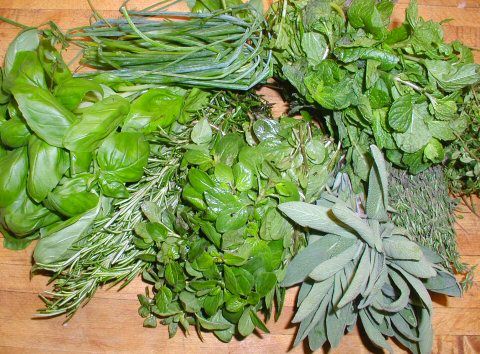
One of the things, among many, that I love about Rome, is Roman food. It would be hard for me to know where to start and where to stop – but the smell of fresh pizza bianca baking at the little shops on the plazas, Romano cheese, everywhere fresh herbs for sale, and, of course, the fifth quarter – i.e., dishes made from all those parts of the animal that are normally left out… offal. Now, I’d thought about making our Roman dinner an “all offal” dinner, and at some point, with a bit more advance notice, I might just do that. But I’d already heard from several of the reserved guests when I posted the Roman theme that they really hoped I wouldn’t do something like that. In the end, I was going to do one, a favorite, Rigatoni alla Pajata – pasta with a tomato sauce in which are stewed the thinnest little intestines of an unweaned calf, with the milk in them cooked right into it all. But you can’t buy those here – it’s an Italian thing. In Argentina, calves can’t be slaughtered for food until they’re much older – one of the reasons that veal here isn’t a white meat, it’s a red meat – they’ve been put out to pasture, so to speak, and developed muscle and eaten grasses and grains. You can’t make the dish with chinchulines, it’s just not the same. So, in the end, no offal. But, I returned to the herbs. Roman cuisine is nothing, if not about fresh herbs… in everything.
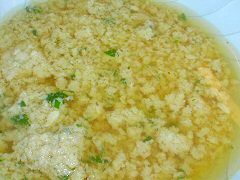 I love stracciatella. Plain and simple, it’s an easy to make soup, and delicious. It’s normally made with chicken broth, or perhaps a lighter beef or veal broth. It happened that I had all sorts of lamb bones left over from a couple of recent dinners, and decided to make a big pot of lamb stock, and then use that for the soup. Just a little touch different, perhaps making the dish slightly heartier for the weather having turned a touch colder. As I said, it’s simple to make. In a bowl, mix together 6 eggs, 8 tablespoons of semolina flour, 8 tablespoons of grated cheese – I used local reggianito, a quarter cup of chopped parsley, a half a teaspoon of nutmeg, and the same of salt. Bring the stock to a light boil, and while whisking the stock, gradually pour the batter mixture into it. It’ll form these little clumps – torn rags, which is what the soup’s name means. Let it simmer for a moment or two and serve.
I love stracciatella. Plain and simple, it’s an easy to make soup, and delicious. It’s normally made with chicken broth, or perhaps a lighter beef or veal broth. It happened that I had all sorts of lamb bones left over from a couple of recent dinners, and decided to make a big pot of lamb stock, and then use that for the soup. Just a little touch different, perhaps making the dish slightly heartier for the weather having turned a touch colder. As I said, it’s simple to make. In a bowl, mix together 6 eggs, 8 tablespoons of semolina flour, 8 tablespoons of grated cheese – I used local reggianito, a quarter cup of chopped parsley, a half a teaspoon of nutmeg, and the same of salt. Bring the stock to a light boil, and while whisking the stock, gradually pour the batter mixture into it. It’ll form these little clumps – torn rags, which is what the soup’s name means. Let it simmer for a moment or two and serve.
I must apologize… well, I guess I don’t have to, but I do… for the lack of a photograph of this dish. I don’t know why, but somehow or other, both nights, I just simply forgot to take one. It was a lovingly mounded scoop of sauted mushrooms in a teardrop shaped bowl, glistening, yes, glistening, with it’s own juices, and dotted with the colors of red and green from the tomatoes and mint… you’ll have to take my word for it. The dish, funghi al tegame, which basically means, mushrooms in a pan. I cut button mushrooms into wedges, chopped up a couple of other types of mushrooms – it’s really a mix of whatever you have available – leaning towards particularly earthy types of fungi. In a large pan, saute lots of chopped garlic with a few anchovies (please get the kind preserved in good olive oil in a jar, not those tinned, dried out sorts in cheap olive oil that taste metallic), until the garlic is starting to color and the anchovies fall apart into a paste. Add the mushrooms, saute until they’ve released their juices and most of the juice has evaporated. Add some chopped, seeded tomatoes (I used two plum tomatoes to two pounds of mushrooms), and a handful of fresh mint leaves. Cook until the juices are all intermingled, and reduced to a syrupy consistency. Add salt and black pepper to taste.
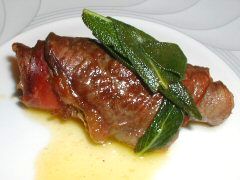
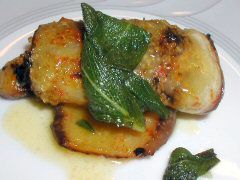
On the first evening of our dinners, I’d been informed in advance that one of the attendees was vegetarian – it turns out she eats fish, so the anchovies above were no problem, and I’d made a one bowl of vegetable broth for her soup. Here, for our veal saltimbocca, I decided to use slices of eggplant for her, that were first roasted, then layered with dulce, a seaweed that gives a smoky flavor, to replace the prosciutto that got rolled into the veal. And I used the same sorts of spices that are used for curing prosciutto, and in the end, the same sauce – a reduction of butter, champagne, and fresh sage leaves. On the second night, we found out that one of our guests was vegetarian when she read the menu and objected to her companions. Luckily, I still had some eggplant, though not roasted, so not pliable, and she ended up with just sauteed sliced eggplant with the sauce – unfortunate, because the version the first night really turned out well. She also got vegetable broth made with a Knorr cube – tasty, but not the same as fresh. See, this is why I ask in advance…
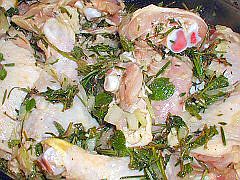
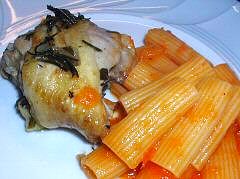
Next up, a personal favorite dish. This is where the herbs really get to shine. It’s called Pollo in Padella, which means, umm, chicken in a pan… though this time, a specific type of pan, a large frying pan. It’s fried chicken, Roman style. The chicken pieces spend the day marinating in a mix of olive oil, fresh lemon juice, and coarsely chopped rosemary, oregano, and thyme, salt, and black pepper. Turn them regularly and make sure that they stay well coated. Then, simply fry them up in a large pan – you don’t really even need more oil, because they’re well coated with it, though I usually add a splash to the pan anyway. Once they’re lightly browned on all sides, add whatever’s left in the marinade pan to the skillet, cover, and cook until the chicken is cooked through. You’ll never go back to shake and bake again… And I had all that Rigatoni I’d bought, planning on my intestine dish, so I made a fresh tomato sauce – literally just pureed together in the blender some tomatoes, white onion, garlic, salt and white pepper, then cooked it for about 20 minutes just to get the raw flavor of the garlic and onions out of it, and at last minute mixed in a large quantity of fresh whole basil leaves and cooked them just until they wilted. For our vegetarians, globe zucchini cut in wedges, the first night marinated in the same mixture as the chicken was marinating in (separately, please) – the second night, I’m afraid I was just able to cook them in some oil, lemon juice, and some quickly chopped herbs – a bit lacking in depth of flavor, such is life.
This, by the way, if I may indulge in a side note, a plea if you will – is why when you have special dietary requests it’s always a good idea to let restaurants know in advance – it gives us time to make a preparation for you that’s worth your coming to try, as opposed to that last minute surprise test that some folks love to throw at us to see what we’ll do – you’ll never get as good quality food when it’s thrown together as when it’s planned out… that’s just part of good cooking – I don’t care how good a chef is, when it’s last minute, he or she has to cut some corners.
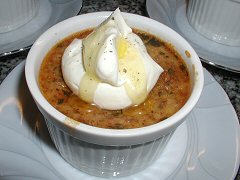 Finally, I went back a few hundred years, to Apicius, one of the first known cookbooks – the cooking of Imperial Rome. Now, it amazes me. Simply, it amazes me. But I found numerous translations of this recipe, and not one of them was the same. Ingredients were roughly the same, but the quantities were vastly different, and would have resulted in everything from a sort of soupy, pudding-like dessert, to a nearly cake-like version. After reading through several, I decided that I’d go for something more or less on the baked custard style. Make a mixture of 8 eggs, 5¼ cups of milk, about ¼ cup of sweet wine, ½ cup of honey, 9 tablespoons of flour, and a pinch of salt. Make sure this is all well mixed, then stir in 1 cup of mixed chopped nuts – making sure that about 1/3 of the mixture is pinenuts – the rest was what I had around – some walnuts, almonds, and peanuts – and, here’s that Roman herbal thing coming in – about 2 tablespoons of chopped rue. Pour the mixture into ramekins and bake until just firmed up and lightly browned on top. I served it with whipped cream that was unsweetened, with honey drizzled over the top, and just a small grind of fresh black pepper – the ancient tradition was to pour a mixture of honey and pepper over the top.
Finally, I went back a few hundred years, to Apicius, one of the first known cookbooks – the cooking of Imperial Rome. Now, it amazes me. Simply, it amazes me. But I found numerous translations of this recipe, and not one of them was the same. Ingredients were roughly the same, but the quantities were vastly different, and would have resulted in everything from a sort of soupy, pudding-like dessert, to a nearly cake-like version. After reading through several, I decided that I’d go for something more or less on the baked custard style. Make a mixture of 8 eggs, 5¼ cups of milk, about ¼ cup of sweet wine, ½ cup of honey, 9 tablespoons of flour, and a pinch of salt. Make sure this is all well mixed, then stir in 1 cup of mixed chopped nuts – making sure that about 1/3 of the mixture is pinenuts – the rest was what I had around – some walnuts, almonds, and peanuts – and, here’s that Roman herbal thing coming in – about 2 tablespoons of chopped rue. Pour the mixture into ramekins and bake until just firmed up and lightly browned on top. I served it with whipped cream that was unsweetened, with honey drizzled over the top, and just a small grind of fresh black pepper – the ancient tradition was to pour a mixture of honey and pepper over the top.
It’s so nice that you feel so strongly about Remus after all this time. What a lovely dinner. I hope he remembers you.
It has been awhile since Remus and I hung out together. Oh, the days at the Roman baths…
[…] might remember the lamb broth based stracciatella, the “old rags” soup, that I made a few weeks ago for our Roman dinner. I don’t […]
I couldn’t refrain from commenting. Very well written!
Thanks!
[…] get around to) – actually, that’s strangely not true – I made it once for these dinners with lamb stock and once with duck stock – but you’ll just have to take my word for it that when I make it […]